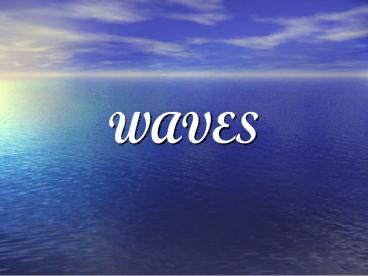WAVES - PowerPoint PPT Presentation
1 / 27
Title:
WAVES
Description:
WAVES What is a wave? We ve all seen waves in a lake or ocean before, but these are just one type of wave. A wave can be defined as A disturbance traveling ... – PowerPoint PPT presentation
Number of Views:358
Avg rating:3.0/5.0
Title: WAVES
1
WAVES
2
What is a wave?
- Weve all seen waves in a lake or ocean before,
but these are just one type of wave. A wave can
be defined as - A disturbance traveling through a medium by
which energy is transferred from one particle of
the medium to another without causing any
permanent displacement of the medium itself.
3
Key points about waves
- Energy is what is moving along the wave.
- Matter is not being transported along the wave,
just energy. - There are many kinds of waves depending on the
medium and the motion of the wave.
4
Important Terms
- Medium the matter through which the wave is
traveling. - Propagation The continuation of a wave
throughout a medium. - Pulse An individual disturbance created in the
medium. (Part of a wave)
5
Types of waves
- All waves can be classified as one of two types
depending on whether or not the wave requires a
medium to travel through.
6
Types of waves
- Mechanical Waves Require a medium to
propagate. - (examples water waves, sound, vibrations on a
string, earthquakes).
7
Types of waves
- Electromagnetic Waves- Do NOT require a medium.
Can travel through a vacuum. - (examples visible light, microwaves, radio,
ultraviolet, infrared, x-rays)
8
Types of waves
- Waves can also be classified based on the
motion of the medium that the wave is traveling
through.
9
Transverse Waves
- Matter is displaced perpendicularly to the motion
of the wave.
10
Transverse Waves
- Notice that the particles of this material are
all moving up and down while the wave is moving
horizontally.
11
Transverse Waves
12
Transverse Waves
- Crest Highest displacement of a wave.
- Trough Lowest displacement of a wave.
13
Transverse Waves
- Amplitude (A) The displacement of a wave at its
crest or trough. - The greater the amplitude, the greater the energy
of the wave.
14
Transverse Waves
15
Transverse Waves
- Wavelength (?) the distance from one crest to
the next crest, or one trough to the next trough.
16
Wave Measurements
- Frequency (f) How many waves go by a certain
point each second. In other words, how
frequently a wave goes by. - Frequency is measured in cycles per second
otherwise known as Hertz (Hz). - 1 cycle/s 1 s-1 1 Hertz 1 Hz
17
Wave speed animation
18
Wave Measurements
- Notice that as the frequency increases, so does
the velocity of the wave. - The Velocity (V) of the wave is directly
proportional to both the wavelength and the
frequency. - V f ?
- Since the units are m s-1, the unit of velocity
is m/s.
19
Wave Measurements
- Since frequency is how many waves per second, the
opposite measurement must be how many seconds per
wave. This is called the Period (T). - T 1 / f f 1 / T
- Since the Period is a measure of time, the unit
is in seconds (s).
20
Wave Measurements
- Velocity can be now expressed as
V ?
f
1 / T
/ T
21
Longitudinal Waves
- Longitudinal waves are similar to transverse
waves, except the oscillations of the medium are
parallel to the motion of the wave, not
perpendicular.
22
Longitudinal Waves
- Compression Area where the matter is
compressed together. (Analogous to a wave crest)
Rarefaction Area where the matter is pulled
apart. (Analogous to the wave trough)
23
Longitudinal Waves
Focus on just one dot and follow it. What do you
notice?
- The red line represents the disturbance that is
creating the waves.
The particles appear to be traveling all the way
across the screen, but look closer.
24
Measuring Longitudinal Waves
- Wavelength The distance between two consecutive
compressions or two consecutive rarefactions.
25
Surface Waves
- Surface waves are unique from transverse and
longitudinal waves because they only exist on the
surfaces of the medium they are moving through. - Examples water waves, earthquakes
26
Surface Waves
- The motion of surface waves is a combination of
transverse and longitudinal characteristics.
Focus on the movement of the two blue dots. In
what direction are they moving? How is their
motion different?
27
Assignment
- Read pg. 381-384
- Do Problems 15-21 on Pg. 386































